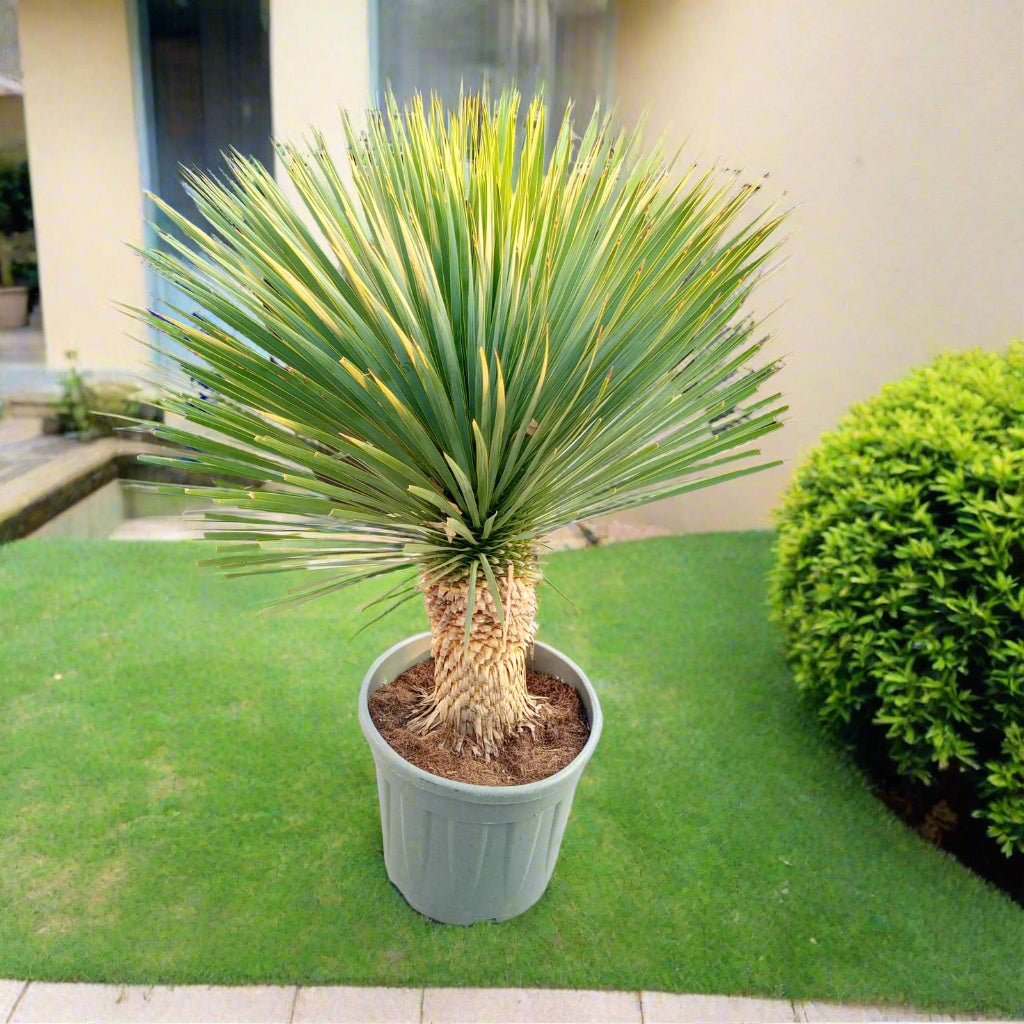نبات اليوكا روستراتا النضر من النوع H3، 10 لتر، 60-80 سم
ضمان الخروج الآمن
حصريًا على الموقع - توصيل مجاني في دبي والشارقة
استبدال مجاني إذا تلقيت منتجًا معيبًا أثناء التسليم

نبات اليوكا روستراتا النضر من النوع H3، 10 لتر، 60-80 سم
نبات اليوكا روستراتا النضر من النوع H3، 10 لتر، 60-80 سم
اليوكا روستراتا، المعروفة باسم اليوكا المنقارية أو اليوكا الزرقاء، هي نبات عصاري مذهل يتحمل الجفاف موطنه الأصلي شمال المكسيك وجنوب غرب الولايات المتحدة. إنه نبات زينة شائع بسبب مظهره المذهل، الذي يتميز بأوراقه الخضراء المزرقة وسيقان الزهور الطويلة. غالبًا ما تستخدم اليوكا روستراتا في تنسيق الحدائق الصحراوية وكنقطة محورية لافتة للنظر في المناظر الطبيعية.
فيما يلي التفاصيل الرئيسية حول Yucca rostrata:
1. المظهر:
الحجم: نبات اليوكا روستراتا هو نبات بطيء النمو يصل ارتفاعه عادة إلى 6 إلى 10 أقدام (1.8 إلى 3 أمتار)، مع نمو بعض العينات إلى ارتفاعات أطول في ظل الظروف المثالية. يميل إلى البقاء أكثر تماسكًا عند زراعته في حاويات أو مساحات أصغر.
الأوراق: للنبات أوراق ضيقة زرقاء مخضرة تشبه السيف تنمو على شكل وردة في أعلى الجذع المركزي. الأوراق مسننة ويمكن أن يصل طولها إلى 60 سم. لونها الأزرق الفضي يمنح النبات مظهرًا مذهلاً، خاصة في ضوء الشمس الساطع.
الجذع: يتطور جذع نبات اليوكا روستراتا إلى جذع خشبي مع تقدمه في السن، مما يمنحه مظهرًا يشبه الشجرة. يكون الجذع عادةً نحيفًا ولكنه يصبح أكثر سمكًا مع تقدم العمر. وغالبًا ما يصبح متفرعًا، وخاصة في النباتات الأكبر سنًا.
الزهور: في أواخر الربيع أو أوائل الصيف، تنتج نبات اليوكا روستراتا سيقان زهور طويلة (يصل طولها إلى 6 أقدام أو 1.8 متر) مع أزهار بيضاء كريمية على شكل جرس تتدلى في مجموعات. تجذب الأزهار الملقحات مثل النحل والطيور الطنانة والفراشات. يمكن أن تستمر فترة الإزهار لعدة أسابيع.
الثمار: بعد الإزهار، قد ينتج النبات كبسولات أو قرون تحتوي على بذور، على الرغم من أنه يزرع في المقام الأول من أجل أوراقه وأزهاره الزينة.
2. الاستخدامات:
نباتات الزينة: تزرع نباتات اليوكا روستراتا عادة كنباتات زينة في الحدائق الصحراوية والمناظر الطبيعية الجافة. لونها الأزرق الفريد وشكلها المعماري يجعلها نقطة محورية ممتازة. كما أنها مناسبة للاستخدام في الحدائق الصخرية أو المناظر الطبيعية الجافة حيث تكون النباتات منخفضة الصيانة ومقاومة للجفاف مرغوبة.
نبات الحاويات: نظرًا لنموه البطيء وحجمه الصغير، فإن نبات اليوكا روستراتا مناسب أيضًا للزراعة في الحاويات. يمكن زراعته في أوعية كبيرة في الأفنية أو الشرفات أو التراسات، مما يجعله خيارًا جيدًا للمساحات الحضرية.
تنسيق الحدائق: يستخدم هذا النوع من اليوكا في تنسيق الحدائق في المناطق ذات المناخ الجاف. احتياجاته المنخفضة من الماء ومظهره الدرامي يجعله مثاليًا لتنسيق الحدائق الصحراوية أو كجزء من تصميم المناظر الطبيعية الأكبر في الأماكن ذات الصيف الحار والجاف.
3. الزراعة:
المناخ: تنمو نباتات اليوكا روستراتا في المناخات الجافة الشبيهة بالصحراء، وهي مناسبة تمامًا لمناطق صلابة وزارة الزراعة الأمريكية من 5 إلى 9. وهي تتحمل البرودة حتى -10 درجة فهرنهايت (-23 درجة مئوية)، مما يجعلها مثالية للمناطق ذات الصيف الحار والشتاء البارد.
الضوء: يحتاج نبات اليوكا روستراتا إلى ضوء الشمس الكامل لينمو بشكل جيد. ينمو نبات اليوكا روستراتا بشكل جيد في ضوء الشمس الساطع المباشر، وقد تصبح أوراقه طويلة أو تفقد لونها النابض بالحياة إذا نمت في ضوء خافت.
التربة: يفضل النبات التربة جيدة التصريف، سواء كانت رملية أو طينية. ويمكنه تحمل مجموعة من أنواع التربة، ولكنه مناسب بشكل خاص للتربة ذات التصريف الجيد لتجنب تعفن الجذور.
الري: نبات اليوكا روستراتا يتحمل الجفاف بدرجة كبيرة ولا يحتاج إلى الكثير من الماء بمجرد نموه. اسق النبات بعمق ولكن بشكل غير متكرر، مع السماح للتربة بالجفاف بين الريات. خلال موسم النمو، سوف يستفيد من الري العميق من حين لآخر، ولكن يجب سقيه بشكل أقل في الشتاء عندما يكون النبات خاملاً.
درجة الحرارة: ينمو هذا النبات في درجات حرارة دافئة إلى حارة ولكنه يتحمل البرودة إلى حد كبير بمجرد نموه. يمكنه تحمل الصقيع ويمكنه البقاء في المناطق ذات الشتاء القاسي، طالما أن درجات الحرارة لا تنخفض كثيرًا لفترات طويلة.
4. الصيانة:
التقليم: يتطلب نبات اليوكا روستراتا القليل جدًا من التقليم. يمكنك إزالة الأوراق الميتة أو التالفة للحفاظ على مظهر النبات. إذا أصبح النبات طويل القامة أو ثقيلًا في الجزء العلوي، يمكنك تقليم الأوراق القديمة، ولكن احرص على عدم إتلاف الجذع أو طرف النمو.
إعادة الزراعة: تنمو نبات اليوكا روستراتا ببطء ولا تحتاج إلى إعادة زراعة متكررة. يمكن إعادة زراعتها كل عامين إلى ثلاثة أعوام أو عندما تصبح جذورها مقيدة. عند إعادة الزراعة، استخدم مزيجًا من الصبار أو النباتات العصارية جيد التصريف وأصيصًا به فتحات تصريف جيدة.
التسميد: لا يحتاج نبات اليوكا هذا إلى الكثير من الأسمدة. يمكنك تسميده مرة واحدة خلال موسم النمو (الربيع أو أوائل الصيف) باستخدام سماد سائل مخفف ومتوازن. تجنب التسميد في أشهر الشتاء عندما يكون النبات في حالة خمول.
5. التكاثر:
البراعم (الصغار): غالبًا ما تنتج نبات Yucca rostrata براعم أو صغارًا عند قاعدة النبات. يمكن فصل هذه البراعم بعناية وإعادة زراعتها في أوعية جديدة أو في الأرض لنشر نباتات جديدة.
العُقَل: يمكن إكثار نبات اليوكا روستراتا من خلال عُقَل السيقان، على الرغم من أن هذه الطريقة أقل شيوعًا من إكثارها من خلال البراعم. اقطع ساقًا ناضجة وصحية، واتركها لتتكون عليها ندبات لبضعة أيام، ثم ازرعها في تربة جيدة التصريف.
البذور: يمكنك أيضًا إكثار النبات بالبذور، على الرغم من أن الأمر يستغرق وقتًا أطول حتى ينضج النبات ويزهر بهذه الطريقة. قم بزرع البذور في تربة جيدة التصريف، واحتفظ بها في مكان دافئ ومشمس حتى تنبت.
6. المشاكل الشائعة:
الإفراط في الري: الإفراط في الري مشكلة شائعة مع نبات اليوكا روستراتا، مما يؤدي إلى تعفن الجذور. تأكد دائمًا من أن التربة جيدة التصريف وأن النبات لا يتراكم عليه فائض من الماء. اترك التربة تجف تمامًا بين الريات.
تغير لون الأوراق إلى البني: قد يحدث تغير لون أطراف الأوراق إلى البني إذا تعرض النبات لحرارة شديدة دون مياه كافية أو إذا كان يتلقى الكثير من المياه. تأكد من أن النبات يتمتع بتصريف مناسب للمياه وعدم الإفراط في الري.
الآفات: نبات اليوكا روستراتا مقاوم نسبيًا للآفات، ولكن من الممكن أن يتأثر أحيانًا بالبق الدقيقي أو الحشرات القشرية أو سوس العنكبوت. ويمكن معالجة هذه الآفات بالصابون المبيد للحشرات أو زيت شجر أزداريختا.



